| Weight | 1 lbs |
|---|---|
| Dimensions | 9 × 5 × 2 in |
| host | mouse |
| isotype | IgG1 |
| clonality | monoclonal |
| concentration | concentrate, predilute |
| applications | IHC |
| reactivity | human |
| available size | 0.1 mL, 0.5 mL, 1 mL concentrated, 7 mL prediluted |
mouse anti-CEA-M monoclonal antibody (CEA31) 6120
Price range: $160.00 through $528.00
Antibody summary
- Mouse monoclonal to CEA-M
- Suitable for: Immunohistochemistry (formalin-fixed, paraffin-embedded tissues)
- Reacts with: Human
- Isotype:IgG1
- Control: Colon carcinoma
- Visualization: Cytoplasmic and luminal membrane
- 0.1, 0.5, 1.0 mL concentrated, 7 mL prediluted
mouse anti-CEA-M monoclonal antibody CEA31 6120
| target relevance |
|---|
| Protein names Cell adhesion molecule CEACAM1 (Biliary glycoprotein 1) (BGP-1) (Carcinoembryonic antigen-related cell adhesion molecule 1) (CEA cell adhesion molecule 1) (CD antigen CD66a) |
| Gene names CEACAM1,CEACAM1 BGP BGP1 |
| Protein family Immunoglobulin superfamily, CEA family |
| Mass 57560Da |
| Function FUNCTION: [Isoform 1]: Cell adhesion protein that mediates homophilic cell adhesion in a calcium-independent manner (By similarity). Plays a role as coinhibitory receptor in immune response, insulin action and also functions as an activator during angiogenesis (PubMed:18424730, PubMed:23696226, PubMed:25363763). Its coinhibitory receptor function is phosphorylation- and PTPN6 -dependent, which in turn, suppress signal transduction of associated receptors by dephosphorylation of their downstream effectors. Plays a role in immune response, of T cells, natural killer (NK) and neutrophils (PubMed:18424730, PubMed:23696226). Upon TCR/CD3 complex stimulation, inhibits TCR-mediated cytotoxicity by blocking granule exocytosis by mediating homophilic binding to adjacent cells, allowing interaction with and phosphorylation by LCK and interaction with the TCR/CD3 complex which recruits PTPN6 resulting in dephosphorylation of CD247 and ZAP70 (PubMed:18424730). Also inhibits T cell proliferation and cytokine production through inhibition of JNK cascade and plays a crucial role in regulating autoimmunity and anti-tumor immunity by inhibiting T cell through its interaction with HAVCR2 (PubMed:25363763). Upon natural killer (NK) cells activation, inhibit KLRK1-mediated cytolysis of CEACAM1-bearing tumor cells by trans-homophilic interactions with CEACAM1 on the target cell and lead to cis-interaction between CEACAM1 and KLRK1, allowing PTPN6 recruitment and then VAV1 dephosphorylation (PubMed:23696226). Upon neutrophils activation negatively regulates IL1B production by recruiting PTPN6 to a SYK-TLR4-CEACAM1 complex, that dephosphorylates SYK, reducing the production of reactive oxygen species (ROS) and lysosome disruption, which in turn, reduces the activity of the inflammasome. Down-regulates neutrophil production by acting as a coinhibitory receptor for CSF3R by down-regulating the CSF3R-STAT3 pathway through recruitment of PTPN6 that dephosphorylates CSF3R (By similarity). Also regulates insulin action by promoting INS clearance and regulating lipogenesis in liver through regulating insulin signaling (By similarity). Upon INS stimulation, undergoes phosphorylation by INSR leading to INS clearance by increasing receptor-mediated insulin endocytosis. This inernalization promotes interaction with FASN leading to receptor-mediated insulin degradation and to reduction of FASN activity leading to negative regulation of fatty acid synthesis. INSR-mediated phosphorylation also provokes a down-regulation of cell proliferation through SHC1 interaction resulting in decrease coupling of SHC1 to the MAPK3/ERK1-MAPK1/ERK2 and phosphatidylinositol 3-kinase pathways (By similarity). Functions as activator in angiogenesis by promoting blood vessel remodeling through endothelial cell differentiation and migration and in arteriogenesis by increasing the number of collateral arteries and collateral vessel calibers after ischemia. Also regulates vascular permeability through the VEGFR2 signaling pathway resulting in control of nitric oxide production (By similarity). Down-regulates cell growth in response to EGF through its interaction with SHC1 that mediates interaction with EGFR resulting in decrease coupling of SHC1 to the MAPK3/ERK1-MAPK1/ERK2 pathway (By similarity). Negatively regulates platelet aggregation by decreasing platelet adhesion on type I collagen through the GPVI-FcRgamma complex (By similarity). Inhibits cell migration and cell scattering through interaction with FLNA; interferes with the interaction of FLNA with RALA (PubMed:16291724). Mediates bile acid transport activity in a phosphorylation dependent manner (By similarity). Negatively regulates osteoclastogenesis (By similarity). {ECO:0000250|UniProtKB:P16573, ECO:0000250|UniProtKB:P31809, ECO:0000269|PubMed:16291724, ECO:0000269|PubMed:18424730, ECO:0000269|PubMed:23696226, ECO:0000269|PubMed:25363763}.; FUNCTION: [Isoform 8]: Cell adhesion protein that mediates homophilic cell adhesion in a calcium-independent manner (By similarity). Promotes populations of T cells regulating IgA production and secretion associated with control of the commensal microbiota and resistance to enteropathogens (By similarity). {ECO:0000250|UniProtKB:P16573, ECO:0000250|UniProtKB:P31809}. |
| Subellular location SUBCELLULAR LOCATION: [Isoform 1]: Cell membrane {ECO:0000250|UniProtKB:P16573}; Single-pass type I membrane protein {ECO:0000250|UniProtKB:P16573}. Lateral cell membrane {ECO:0000250|UniProtKB:P16573}. Apical cell membrane {ECO:0000250|UniProtKB:P16573}. Basal cell membrane {ECO:0000250|UniProtKB:P16573}. Cell junction {ECO:0000269|PubMed:16291724}. Cell junction, adherens junction {ECO:0000250|UniProtKB:P16573}. Note=Canalicular domain of hepatocyte plasma membranes. Found as a mixture of monomer, dimer and oligomer in the plasma membrane. Occurs predominantly as cis-dimers and/or small cis-oligomers in the cell junction regions. Found as dimer in the solution. Predominantly localized to the lateral cell membranes. {ECO:0000250|UniProtKB:P16573}.; SUBCELLULAR LOCATION: [Isoform 2]: Secreted {ECO:0000269|PubMed:2025273}.; SUBCELLULAR LOCATION: [Isoform 3]: Secreted {ECO:0000269|PubMed:2025273}.; SUBCELLULAR LOCATION: [Isoform 4]: Secreted {ECO:0000269|PubMed:2025273}.; SUBCELLULAR LOCATION: [Isoform 5]: Cell membrane; Single-pass type I membrane protein.; SUBCELLULAR LOCATION: [Isoform 6]: Cell membrane; Single-pass type I membrane protein.; SUBCELLULAR LOCATION: [Isoform 7]: Cell membrane; Single-pass type I membrane protein.; SUBCELLULAR LOCATION: [Isoform 8]: Cell membrane {ECO:0000269|PubMed:14522961}; Single-pass type I membrane protein {ECO:0000250|UniProtKB:P16573}. Cytoplasmic vesicle, secretory vesicle membrane {ECO:0000269|PubMed:14522961}. Lateral cell membrane {ECO:0000250|UniProtKB:P16573}. Apical cell membrane {ECO:0000250|UniProtKB:P16573}. Basal cell membrane {ECO:0000250|UniProtKB:P16573}. Cell junction {ECO:0000269|PubMed:8018919}. Cell junction, adherens junction {ECO:0000250|UniProtKB:P16573}. Note=Predominantly localized to the lateral cell membranes. Found as a mixture of monomer, dimer and oligomer in the plasma membrane. Occurs predominantly as cis-dimers and/or small cis-oligomers in the cell junction regions (By similarity). Co-localizes with ANXA2 in secretory vesicles and with S100A10/p11 at the plasma membrane (PubMed:14522961). {ECO:0000250|UniProtKB:P16573, ECO:0000269|PubMed:14522961}.; SUBCELLULAR LOCATION: Cell projection, microvillus membrane {ECO:0000250|UniProtKB:P31809}; Single-pass type I membrane protein {ECO:0000305}. Apical cell membrane {ECO:0000269|PubMed:10436421}; Single-pass type I membrane protein {ECO:0000305}. Note=Localized to the apical glycocalyx surface (PubMed:10436421). Colocalizes with CEACAM20 at the apical brush border of intestinal cells. {ECO:0000250|UniProtKB:P31809, ECO:0000269|PubMed:10436421}. |
| Tissues TISSUE SPECIFICITY: Expressed in columnar epithelial cells of the colon (at protein level) (PubMed:10436421). The predominant forms expressed by T cells are those containing a long cytoplasmic domain (PubMed:18424730). Expressed in granulocytes and lymphocytes. Leukocytes only express isoforms 6 and isoform 1 (PubMed:11994468). {ECO:0000269|PubMed:10436421, ECO:0000269|PubMed:11994468, ECO:0000269|PubMed:18424730}. |
| Structure SUBUNIT: Monomer. Oligomer. Heterodimer. Homodimer (PubMed:26483485). Cis-dimer/oligomer (via Ig-like C2-type and/or via cytoplasmic domains); induced by trans-homophilic cell adhesion through an allosteric mechanism transmitted by the Ig-like V-type domain, and is regulated by intracellular calcium and calmodulin. Interacts (via cytoplasmic domain) with calmodulin in a calcium dependent manner; reduces homophilic cell adhesion through dissociation of dimer (By similarity). Isoform 1 interacts (via cytoplasmic domain) with PTPN11 (preferentially) and PTPN6; cis-homodimer form is preferred; this interaction is decreased by formation of Isoform 1 /Isoform 8 cis-heterodimers and is dependent on the monomer/dimer equilibrium; this interaction is phosphorylation-dependent (PubMed:23696226). Isoform 1 interacts with LYN (By similarity). Isoform 1 interacts (via cytoplasmic domain) with SRC (via SH2 domain); this interaction is regulated by trans-homophilic cell adhesion (PubMed:7478590). Isoform 1 interacts (via cytoplasmic domain) with LCK; mediates phosphorylation at Tyr-493 and Tyr-520 resulting in PTPN6 association. Isoform 1 interacts with PTPN6; this interaction is phosphorylation-dependent and causes a profound decrease in TCR stimulation-induced CD247 and ZAP70 phosphorylation. Isoform 1 interacts with TCR/CD3 complex through TCR beta chain and CD3E; colocalizes at the cell surface and upon stimulation of the TCR/CD3 complex recruits PTPN6 in the TCR/CD3 complex, resulting in dephosphorylation of CD247 and ZAP70 (PubMed:18424730). Isoform 1 interacts (via cytoplasmic domain) with SHC1 (via SH2 domain); SHC1 mediates interaction with INSR or EGFR in a Ser-508 phosphorylation-dependent manner (By similarity). Isoform 1 interacts with EGFR; the interaction is indirect (PubMed:15467833). Isoform 1 interacts with CSF3R; down-regulates the CSF3R-STAT3 pathway through recruitment of PTPN6 that dephosphorylates CSF3R (By similarity). Isoform 1 (phosphorylated form) interacts with TLR4 and SYK; recruits PTPN6 that dephosphorylates SYK, reducing the production of reactive oxygen species (ROS) and lysosome disruption, leading to a reduction of the inflammasome activity (By similarity). Isoform 1 interacts with FLNA; inhibits cell migration and cell scattering by interfering with the interaction of FLNA with RALA (PubMed:16291724). Isoform 1 interacts (via cytoplasmic domain) with PXN; the interaction is phosphotyrosyl-dependent (PubMed:11035932). Isoform 1 interacts with KLRK1; recruits PTPN6 that dephosphorylates VAV1 (PubMed:23696226). Isoform 1 interacts with CEACAM8 (PubMed:11994468). Isoform 1 interacts with FASN; this interaction is insulin and phosphorylation-dependent; reduces fatty-acid synthase activity (By similarity). Interacts (via Ig-like V-type) with HAVCR2 (via Ig-like V-type); facilitates the maturation and cell surface expression of HAVCR2 thereby regulating T cell tolerance induction (PubMed:25363763). Isoform 8 interacts (via the cytoplasmic domain) with ANXA2; this interaction is regulated by phosphorylation and appears in the AIIt complex (PubMed:14522961). Interacts (via Lewis X moieties) with CD209 (via C-type lectin domain); this interaction is regulated by the glycosylation pattern of CEACAM1 on cell types and regulates contact between dendritic cells and neutrophils (PubMed:16246332). {ECO:0000250|UniProtKB:P16573, ECO:0000250|UniProtKB:P31809, ECO:0000269|PubMed:11035932, ECO:0000269|PubMed:11994468, ECO:0000269|PubMed:14522961, ECO:0000269|PubMed:15467833, ECO:0000269|PubMed:16246332, ECO:0000269|PubMed:16291724, ECO:0000269|PubMed:18424730, ECO:0000269|PubMed:23696226, ECO:0000269|PubMed:25363763, ECO:0000269|PubMed:26483485, ECO:0000269|PubMed:7478590}. |
| Post-translational modification PTM: [Isoform 1]: Phosphorylated on serine and tyrosine (By similarity). Isoform 1 is phosphorylated on tyrosine by Src family kinases like SRC and LCK and by receptor like CSF3R, EGFR and INSR upon stimulation (PubMed:15467833, PubMed:18424730, PubMed:7478590). Phosphorylated at Ser-508; mediates activity. Phosphorylated at Tyr-493; regulates activity (By similarity). Phosphorylated at Tyr-493 by EGFR and INSR upon stimulation; this phosphorylation is Ser-508-phosphorylation-dependent; mediates cellular internalization; increases interaction with downstream proteins like SHC1 and FASN (By similarity). Phosphorylated at Tyr-493 and Tyr-520 by LCK; mediates PTPN6 association and is regulated by homophilic ligation of CEACAM1 in the absence of T cell activation (PubMed:18424730). Phosphorylated at Tyr-520; mediates interaction with PTPN11 (By similarity). {ECO:0000250|UniProtKB:P16573, ECO:0000250|UniProtKB:P31809, ECO:0000269|PubMed:15467833, ECO:0000269|PubMed:18424730, ECO:0000269|PubMed:7478590}.; PTM: [Isoform 8]: Phosphorylated on serine and threonine. {ECO:0000269|PubMed:14522961}. |
| Domain DOMAIN: Ig-like V-type domain mediates trans-homophilic cell adhesion through homodimerization and this active process is regulated by tyrosine kinase, PTPN11 and PTPN6. Ig-like C2-type and/or cytoplasmic domains mediate cis-dimer/oligomer. {ECO:0000250|UniProtKB:P16573}. |
| Target Relevance information above includes information from UniProt accession: P13688 |
| The UniProt Consortium |
Data
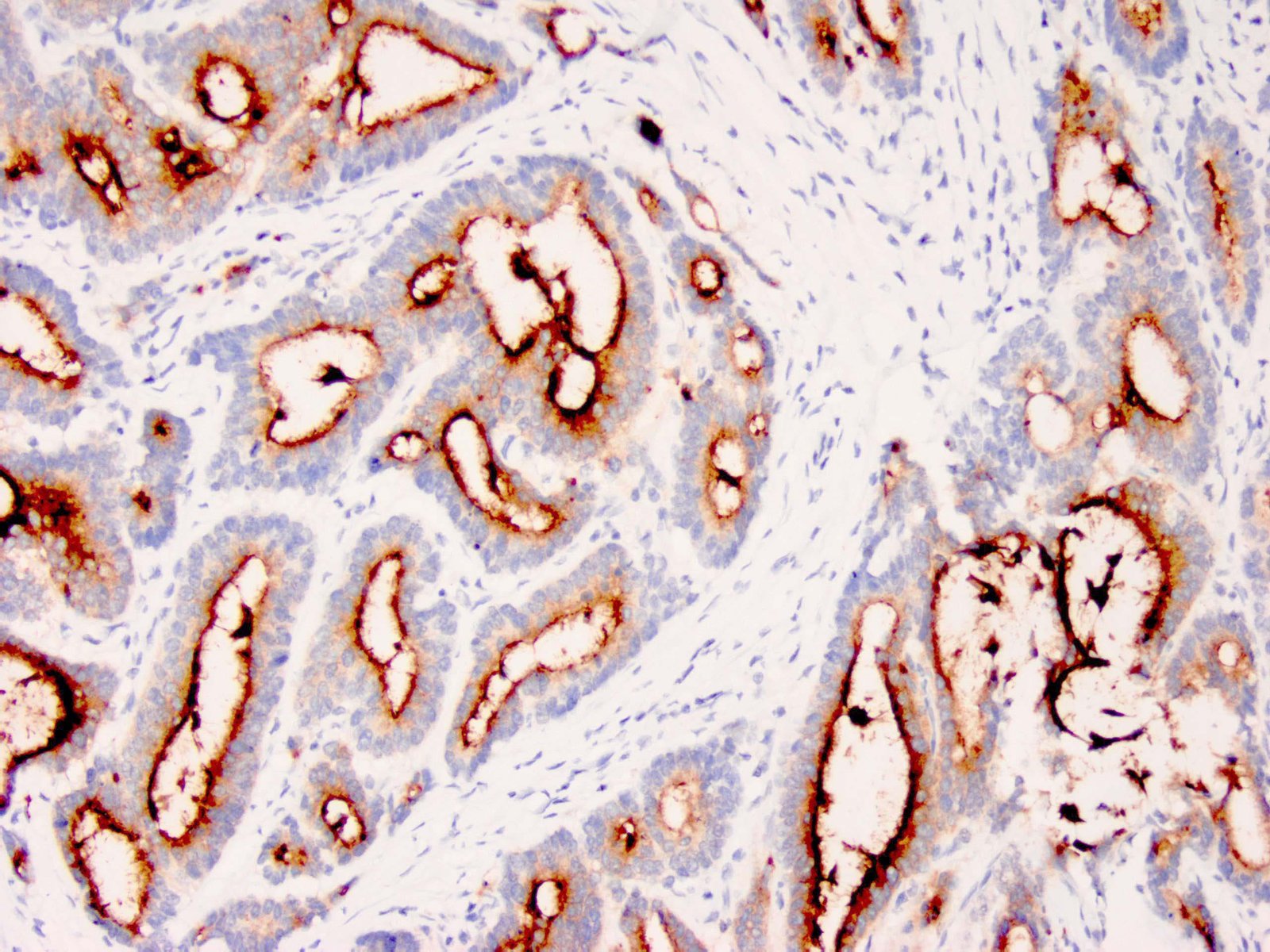 |
| Human colon carcinoma stained with anti-CEA monoclonal antibody using peroxidase-conjugate and DAB chromogen. Note cytoplasmic and luminal surface staining of tumor cells. |
Publications
| pmid | title | authors | citation |
|---|---|---|---|
| We haven't added any publications to our database yet. | |||
Protocols
| relevant to this product |
|---|
| IHC |
Documents
| # | SDS | Certificate | |
|---|---|---|---|
| Please enter your product and batch number here to retrieve product datasheet, SDS, and QC information. | |||
Only logged in customers who have purchased this product may leave a review.

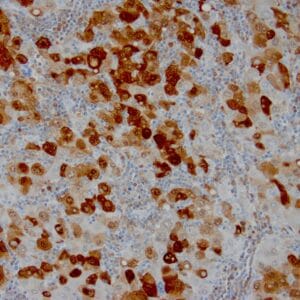
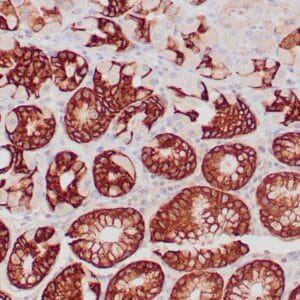

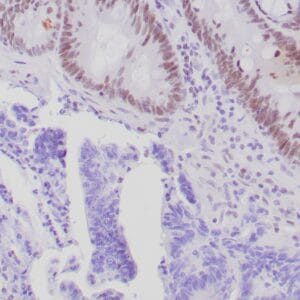


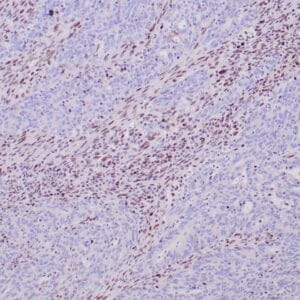
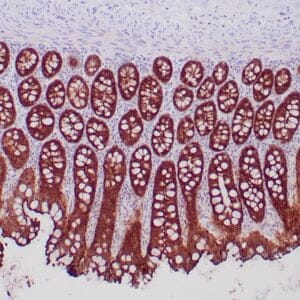
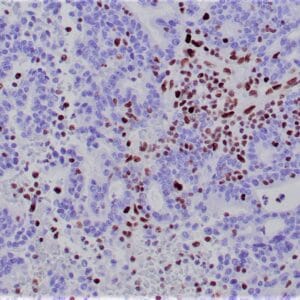
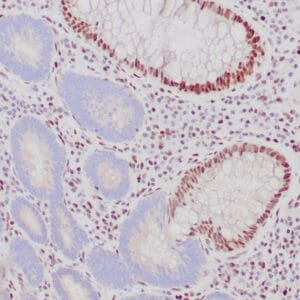
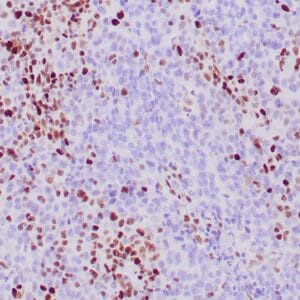

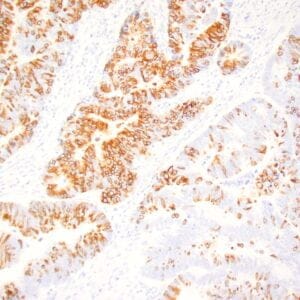

Reviews
There are no reviews yet.